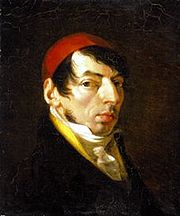
Jan Rustem
Encyclopedia

Painting
Painting is the practice of applying paint, pigment, color or other medium to a surface . The application of the medium is commonly applied to the base with a brush but other objects can be used. In art, the term painting describes both the act and the result of the action. However, painting is...
of Armenian, Turkish or Greek ethnicity who lived and worked in the territories of the Polish–Lithuanian Commonwealth. Primarily a portrait painter
Portrait painting
Portrait painting is a genre in painting, where the intent is to depict the visual appearance of the subject. Beside human beings, animals, pets and even inanimate objects can be chosen as the subject for a portrait...
, he was commissioned to execute portraits of notable personalities of his epoch. For many years he was a professor at the University of Vilna, the predecessor of Vilnius University
Vilnius University
Vilnius University is the oldest university in the Baltic states and one of the oldest in Eastern Europe. It is also the largest university in Lithuania....
.
He was born in Istanbul
Istanbul
Istanbul , historically known as Byzantium and Constantinople , is the largest city of Turkey. Istanbul metropolitan province had 13.26 million people living in it as of December, 2010, which is 18% of Turkey's population and the 3rd largest metropolitan area in Europe after London and...
, and a young boy was sponsored by Adam Kazimierz Czartoryski who invited him to the Commonwealth around 1774. Czartoryski paid for his studies in Warsaw
Warsaw
Warsaw is the capital and largest city of Poland. It is located on the Vistula River, roughly from the Baltic Sea and from the Carpathian Mountains. Its population in 2010 was estimated at 1,716,855 residents with a greater metropolitan area of 2,631,902 residents, making Warsaw the 10th most...
, where among his tutors were Jean-Pierre Norblin de La Gourdaine and Marcello Bacciarelli
Marcello Bacciarelli
Marcello Bacciarelli was an Italian painter of the late-baroque and Neoclassic periods.He studied in Rome under Marco Benefial. In 1750 he was called to Dresden, Saxony, where he was employed by Elected King Augustus III of Poland; after whose death he went to Vienna, and thence to Warsaw...
. Between 1788 and 1790 he moved to Germany, where he became a freemason. Two years later he returned to the Polish–Lithuanian Commonwealth and lived for some time in Warsaw
Warsaw
Warsaw is the capital and largest city of Poland. It is located on the Vistula River, roughly from the Baltic Sea and from the Carpathian Mountains. Its population in 2010 was estimated at 1,716,855 residents with a greater metropolitan area of 2,631,902 residents, making Warsaw the 10th most...
, later moving to Vilna
Vilnius
Vilnius is the capital of Lithuania, and its largest city, with a population of 560,190 as of 2010. It is the seat of the Vilnius city municipality and of the Vilnius district municipality. It is also the capital of Vilnius County...
.
Following the partitions of the Commonwealth
Partitions of Poland
The Partitions of Poland or Partitions of the Polish–Lithuanian Commonwealth took place in the second half of the 18th century and ended the existence of the Polish–Lithuanian Commonwealth, resulting in the elimination of sovereign Poland for 123 years...
, Rustem started working for the Common School of Vilna, which was later remamed the Imperial University of Vilna, as assistant to Franciszek Smuglewicz
Franciszek Smuglewicz
Franciszek Smuglewicz or Pranciškus Smuglevičius, October 6, 1745 – September 18, 1807) was a Polish-Lithuanian draughtsman and painter. Smuglewicz is considered a progenitor of Lithuanian art in the modern era. Some consider him as a spiritual father of Jan Matejko's school of painting....
. After Smuglewicz's death, Rustem took over some of his duties. In 1811 he became a professor of sketching and in 1819 became a professor of painting. Rustem retired in 1826, but continued to give lectures until his death. Among his successful students were Taras Shevchenko
Taras Shevchenko
Taras Hryhorovych Shevchenko -Life:Born into a serf family of Hryhoriy Ivanovych Shevchenko and Kateryna Yakymivna Shevchenko in the village of Moryntsi, of Kiev Governorate of the Russian Empire Shevchenko was orphaned at the age of eleven...
, Józef Oleszkiewicz, Kanuty Rusiecki, and Michał Kulesza
Michał Kulesza
The Romantic painter Michał Kulesza was among the first lithographers in the area of the former Grand Duchy of Lithuania, ruled by Russia for almost all of his life. His frequent theme, sites linked to the Grand Duchy's history, reflected the growing Lithuanian and Polish ethnic activism in the area...
.

